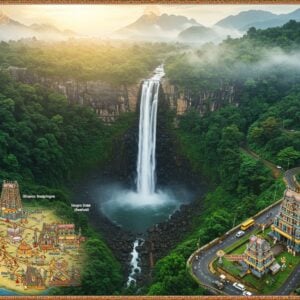
Embark on a sacred journey through the heart of Tamil Nadu, exploring the 275 Paadal Petra Sthalams, revered temples celebrated in the Thevaram hymns. These ancient sites, predominantly dedicated to Lord Shiva, resonate with the divine melodies of Tamil Saiva saints, offering a glimpse into India’s rich spiritual and architectural heritage. This pilgrimage invites you to connect with the divine, experience the power of ancient hymns, and witness the beauty of Dravidian artistry.
Understanding the Significance of Paadal Petra Sthalams
What exactly is a Paadal Petra Sthalam? The term translates to “sacred places praised in song,” referring to temples glorified in the Tevaram, a collection of devotional hymns by the Nayanmars, Tamil Saiva saints. These hymns, born from profound spiritual experiences, act as a guide to these sacred sites, each echoing with centuries of devotion and cultural significance.
These 275 temples, primarily situated in Tamil Nadu, with a few extending to other parts of India, represent a vibrant tapestry of Shaivism. They are not merely structures of stone and mortar, but living testaments to the deep-rooted faith and cultural heritage of the region.
Exploring the 275 Sacred Sites
The 275 Paadal Petra Sthalams offer a diverse range of architectural marvels, historical narratives, and spiritual practices. From the majestic Chidambaram Nataraja Temple, renowned for its cosmic dance of Lord Shiva, to the serene Thillai Kali Temple, each site possesses a unique charm and significance.
- Diversity in Architecture and Rituals: Each temple showcases unique architectural features and rituals, reflecting the rich tapestry of Tamil Nadu’s heritage. Some boast intricate carvings and towering gopurams, while others offer unique spiritual practices passed down through generations.
- Festivals and Celebrations: The temples come alive during festivals, drawing pilgrims from far and wide. These vibrant celebrations showcase the cultural richness of the region through music, dance, and traditional rituals.
- Accessibility and Planning: While some temples are easily accessible, others are nestled in remote areas. Planning your visit, considering travel options and accommodation, is essential for a fulfilling pilgrimage. Check temple timings beforehand and consider visiting during festival seasons for a truly immersive experience.
For detailed maps and information, several resources prove invaluable:
- Google Maps: Utilize resources like Kamesh Kumar’s Map and Raju’s Temple Visits for comprehensive maps and temple details.
- Online Lists and Information: Websites like Wikipedia, Scribd, Divine Traveller, and 276 Shiva Temples offer curated lists and valuable insights into each sthalam.
- Regional Temple Resources: Explore websites like Om Namasivaya and TN Temples Project for detailed information on temples across Tamil Nadu.
Planning Your Spiritual Journey
A pilgrimage to the Paadal Petra Sthalams requires careful planning. Consider your travel options, local transportation, and accommodation. Guided tours can greatly enhance your understanding of the historical and cultural context of each temple.
- Respecting Local Customs: Immersing yourself in the local culture by respecting customs and traditions enhances the spiritual experience and fosters a deeper connection with the community.
- Essential Packing: Pack comfortable clothing and footwear suitable for long temple visits. Carry essentials like water bottles and sunscreen.
- Leveraging Technology: Utilize online resources, travel apps, and temple websites for planning, navigation, and gaining insights into temple timings and rituals.
Poojn.in: Your Companion on this Sacred Journey
Poojn.in, India’s leading online store for cultural and religious goods, offers a wide range of products to support your pilgrimage to the Paadal Petra Sthalams. We provide everything you need for a meaningful and fulfilling temple visit.
Explore Our Offerings:
- Pooja Samagri (186 products): Find all the essential items for your puja rituals.
- Holy Utensils (40 products): Discover traditional brass and copper utensils for temple offerings.
- Holy Clothing: Shop for pure cotton vastrams (temple clothing) for a respectful and traditional attire.
- Devotional Items: Explore a wide range of devotional items to enhance your spiritual practice.
Experience the Convenience:
- Home delivery across India
- Quality-checked authentic items
- Expert guidance on product selection
- WhatsApp support: 9476142738
- Customer service: 03369029784
Visit poojn.in today to prepare for your sacred journey.
The Cultural and Spiritual Impact
The Paadal Petra Sthalams are more than just places of worship; they are vibrant cultural centers, deeply interwoven with the fabric of Tamil Nadu’s heritage. These temples play a vital role in preserving ancient traditions, fostering religious learning, and inspiring spiritual growth. They serve as a bridge between the past and the present, connecting devotees to centuries of devotion and cultural richness.
The festivals celebrated at these temples are an integral part of Tamil culture, showcasing traditional art forms, music, and literature. These celebrations bring communities together, fostering a sense of unity and shared spiritual experience. The temples also contribute significantly to the local economy through religious tourism, supporting local communities and preserving traditional crafts.
Embracing the Journey Beyond the Temples
As you conclude your pilgrimage, you carry not just memories, but a deeper understanding of Tamil Saiva traditions. The hymns of the Nayanmars, the stories of the deities, and the rituals witnessed resonate within, enriching your spiritual journey.
The Paadal Petra Sthalams are not just a destination, but a pathway to spiritual exploration. They invite you to connect with your inner self, experience the power of ancient traditions, and embrace the divine. Let this journey be a celebration of faith, culture, and the timeless spirit of these sacred sites.
FAQs: Your Questions Answered
What makes a Paadal Petra Sthalam unique? A Paadal Petra Sthalam is distinguished by its mention in the Tevaram hymns, sung by the revered Nayanmars. These hymns highlight the temple’s spiritual significance and its connection to the saints’ divine experiences.
How many of these sacred sites exist? There are 275 Paadal Petra Sthalams, primarily located across Tamil Nadu, with a few in other parts of South India.
Why are these temples so important? These sthalams hold immense religious and cultural importance within Shaivism and Tamil culture. They are not just places of worship, but centers of spiritual learning, historical significance, and vibrant cultural expression.
Where can I find a comprehensive list? You can find detailed lists of Paadal Petra Sthalams in various religious texts, dedicated guidebooks, and online resources related to Saivism. Many websites offer comprehensive lists with descriptions and locations.
Who were the Nayanmars? The Nayanmars were a group of 63 Tamil saints devoted to Lord Shiva. Their devotional hymns, compiled in the Tevaram, played a crucial role in establishing the significance of the Paadal Petra Sthalams. They brought these temples to the forefront of religious consciousness and helped spread Shaivism throughout the region.
Is it possible to visit all the temples? While visiting all 275 temples is a significant undertaking, it’s certainly possible with careful planning and adequate time. Many devotees embark on this pilgrimage as a journey of faith, exploring the diverse landscapes and spiritual experiences each temple offers. Consider breaking your journey into smaller segments, focusing on specific regions or clusters of temples.
Do these temples have specific rituals? Yes, many Paadal Petra Sthalams have unique rituals and festivals specific to their history and local traditions. It’s recommended to research individual temples beforehand to understand their specific customs and timings to fully experience their spiritual atmosphere. Connecting with local communities and temple authorities can provide further insight into these unique practices. Consider visiting Mumba Devi Temple for experiencing special rituals & its accessibility from this location.


